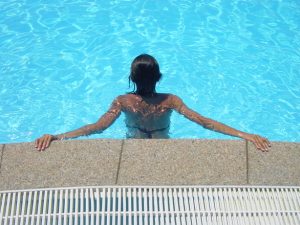According to a new report released by the U.S. Consumer Product Safety Commission. child drownings are on the rise.
And these drownings tend to occur right at home in residential swimming pools.
“Our latest report confirms that most child drownings take place at home during the summer months,” CPSC said in a June 3, 2020, statement.
The report attributes the bulk of child drownings to inadequate adult supervision, which underscores the importance of continuous, vigilant supervision when children are swimming or even near a pool or other body of water. Drownings can occur in any body of water, including in-ground pools, above-ground pools, spas, hot tubs, wading pools, portable pools, and kiddie pools.
In 2020 with more families hunkered down at home because of the spread of COVID-19, CPSC called on people to increase safety efforts and reverse the upward trend in child drownings.
Child Drownings Are the Main Cause of Accidental Death Among Very Young Children
Not only are child drownings on the rise, but they probably occur more often than you might think. Did you know that child drownings are the number one cause of unintentional death among children ages 1 to 4?
Here are some additional statistics about child drownings as reported by CPSC:
- On average, there were 379 pool or spa drownings per year from 2015 to 2017 that involved children under the age of 15.
- Home pools accounted for 71% of the reported drownings.
- Children younger than 5 accounted for 75% of child drownings from 2015 to 2017, and 56% of those drownings were caused by a “gap” in adult supervision.
CPSC also said there were approximately 6,700 pool- or spa-related near-drowning incidents where children received treatment at hospital emergency rooms in the two years from 2017 to 2019. That means that about 18 children suffer nonfatal pool- or spa-related injuries every single day of the year.
Near-drowning accidents can leave children with serious injuries, including traumatic brain injuries that can impact them for the rest of their lives. If the brain is deprived of oxygen for even a short period of time, the damage can be severe and oftentimes irreversible.
Besides drowning or near-drowning, swimming pools present numerous other hazards. Diving boards can cause serious injuries, especially if they’re defective, improperly maintained, or misused. If a diving board is installed in a pool that’s not deep enough, a diver can break his or her neck and become paralyzed. Other common diving board injuries include broken bones, head injuries, spinal cord injuries, nerve damage, and lacerations.
Pool slides can present similar dangers. In addition, slides and kiddie pools are often breeding grounds for disease because they don’t receive the same germ-fighting treatments as swimming pools and hot tubs. Children swimming in contaminated water can contract norovirus, Shigella, E. coli, or other infectious diseases. You can read more about recreational water illnesses on the U.S. Centers for Disease Control and Prevention’s website.
Pool owners who are negligent in maintaining their pools and keeping them in a safe condition can be held liable for drownings and other pool-related injuries. Likewise, pool equipment manufacturers can be held responsible for defective equipment that causes injury to swimmers.
Child and Adult Drownings in Massachusetts
Massachusetts provides information about child and adult drownings on its website at mass.gov. There were 39 unintentional drowning deaths and 223 nonfatal near-drowning incidents in Massachusetts in 2015 that required medical treatment at a hospital.
As for adolescents and adults, 25% to 50% percent of water recreational deaths affecting that age group involve alcohol, which can affect balance, coordination and judgment. Massachusetts adolescents and adults are more likely to drown in natural bodies of water, such as lakes and rivers.
Other factors that can increase a person’s risk of drowning include not knowing how to swim, lack of proper pool fencing, and certain seizure disorders.
Most people assume that a person who is drowning will splash, call for help or wave their arms. However, drowning often happens quickly and quietly without any splashing or cries for help, according to the state.
Actions Parents Can Take to Prevent Child Drownings and Other Pool and Spa Injuries
CPSC suggests that parents and other caregivers take the following steps to keep children safe when they are in water:
- Never leave a child unattended when he or she is in water or near it. Water includes not only pools and spas but bathtubs, wading pools, decorative ponds, and fountains. Young children can drown in less than two inches of water.
- Designate an adult “water watcher” who is focused on the child and not engaged in other activities such as reading or using a cellphone.
- Learn how to perform CPR on both children and adults.
- Learn how to swim and make sure your child knows how to swim.
- Keep children away from pool drains, pipes, and other dangerous openings and make sure that drain covers comply with federal safety standards.
The CDC also offers information for safe pool use.
In Massachusetts, swimming pool owners must surround their pools with a fence at least four-feet tall and equip the fence with a locking gate. The lock must be at least four feet above the ground so that children can’t access it. These fencing regulations apply to in-ground pools, above-ground pools and hot tubs, and spas. If a child drowns in a residential pool or spa or suffers some other injury because the pool or spa was not properly fenced in, the homeowner can be held responsible.
You can read more about residential swimming pool regulations in Massachusetts here.
To learn more about how the personal injury lawyers at Jeffrey Glassman Injury Lawyers, LLC can help you with a drowning, near-drowning, or other pool injury claim, contact our law firm today at (617) 777-7777 or through our online form.
 Boston Personal Injury Attorney Blog
Boston Personal Injury Attorney Blog

